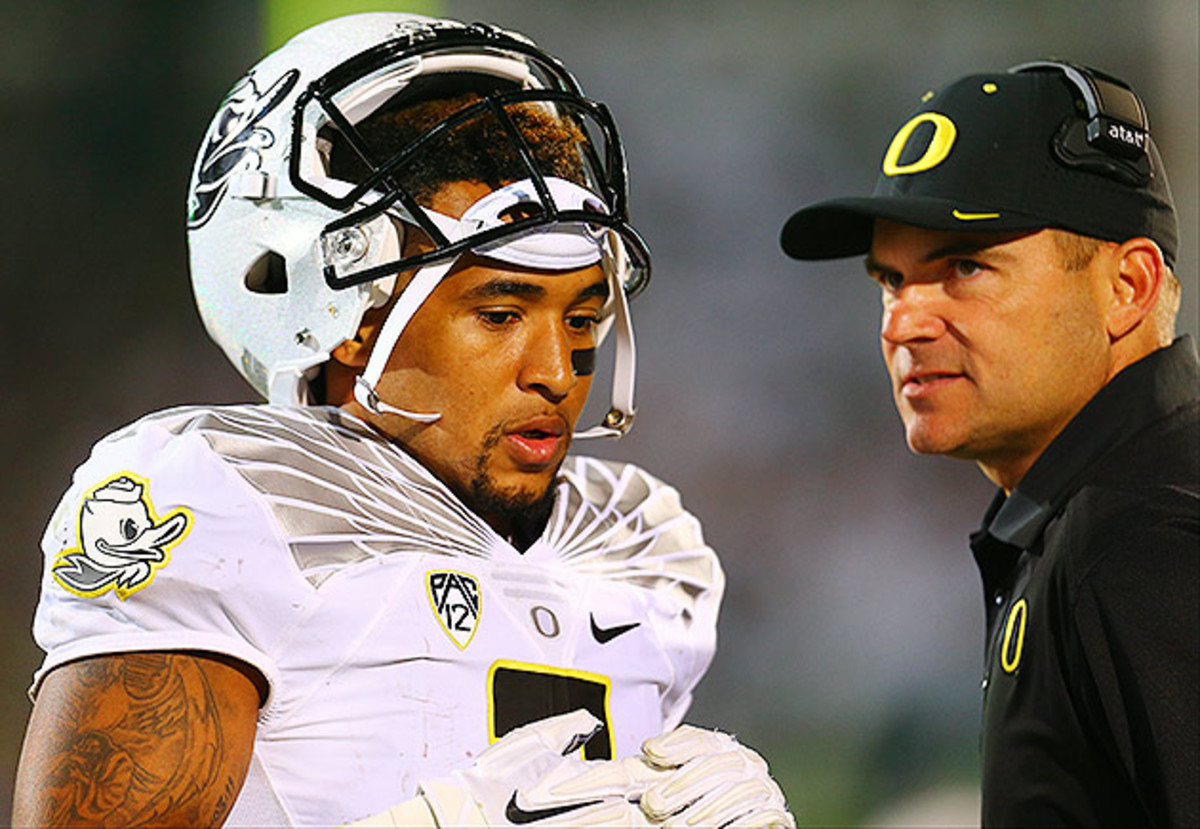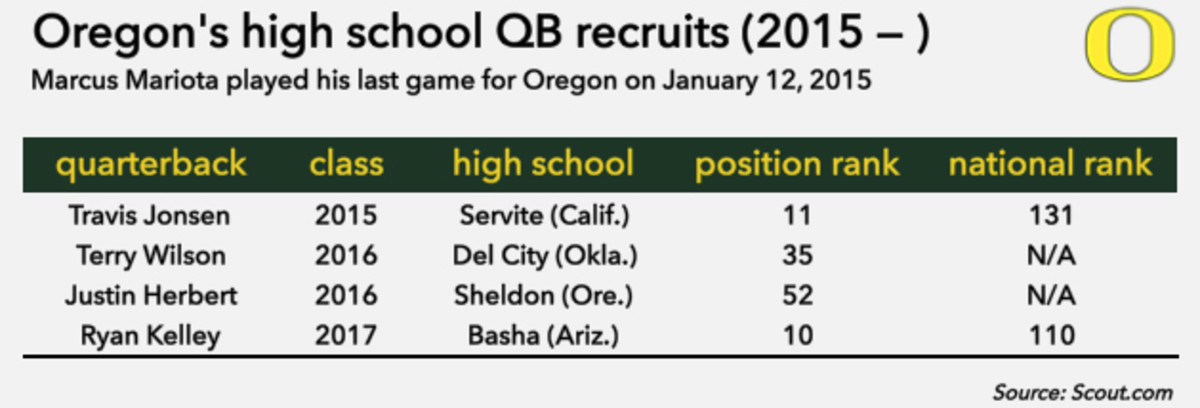Does Oregon have a quarterback recruiting problem?

Get all of Chris Johnson’s columns as soon as they’re published. Download the new Sports Illustrated app (iOS or Android) and personalize your experience by following your favorite teams and SI writers.
In December, less than three weeks before Oregon’s last game of the 2015 season, the Ducks received some excellent news. Dakota Prukop announced that he would use his final year of eligibility at Oregon. A star quarterback at Football Championship Subdivision school Montana State, Prukop had been pursued by several big-name programs, including Alabama and Texas. He would be able to play for the Ducks right away after graduating from Montana State and offered a tantalizing dual-threat skill set, an impressive track record—3,025 passing yards and 28 touchdowns plus 797 rushing yards and 11 scores on the ground in 2015—and an academic timeline that would allow him to be on campus for spring workouts. Prukop, it seemed, could become a potent triggerman for Oregon’s high-octane offense.
But the optimism over his addition shrouded an important question: What’s going on with the Ducks’ high school quarterback recruiting? After using another FCS transfer QB last season who came from the same conference (the Big Sky) as Prukop—erstwhile Eastern Washington standout Vernon Adams—Oregon was tapping the FCS pipeline again instead of leaning on one of its home-grown options. Clearly this is not a sustainable long-term strategy. Prukop is the favorite to win the starting quarterback job in 2016, but he’ll only be around for one season. Are the Ducks prepared to make a smooth transition once he leaves?
Let’s back up for a second. Anyone questioning whether Oregon can produce quality quarterbacks need only look back to last year, when Marcus Mariota was selected second overall in the NFL draft after wrapping up one of the best college quarterback careers ever—including 36 wins over three seasons and a Heisman Trophy. In Mariota’s case, the Ducks exhibited scouting proficiency by unearthing the lightly pursued three-star prospect in Honolulu; developmental prowess by grooming Mariota into a star; and tactical acumen by deploying Mariota in a manner that accentuated his blazing speed and accurate arm.
• BECHT: Get to know No. 1 recruit Najee Harris
Oregon has brought in top-end QB talent since Mariota left college. Greg Biggins, a national recruiting analyst for Scout.com, says he thinks Mariota’s success made the Ducks a more appealing destination for quarterback prospects. “I would say Marcus’s success definitely was a huge, huge boon for their quarterback recruiting,” Biggins says. He adds, “When I saw Marcus do so well after [Jeremiah] Masoli did so well, after [Darron] Thomas did so well, I’m thinking, ‘Shoot, Oregon’s system is so good, you can put anybody back there.’ That’s what everybody was thinking: It’s the system, not the quarterback.” Yet despite that seemingly foolproof system, Oregon doesn’t seem to have found a viable solution at the position from the high school ranks after Mariota.

Last year Adams beat out the Ducks’ other quarterbacks for the top spot on the depth chart even though he wasn’t cleared to begin practicing until he passed a math test in the middle of August.
That in itself is not a huge indictment on the Ducks’ other signal callers; Adams was one of the nation’s best players, full stop. However, the depths to which Oregon’s offense sank in Adams’s absence were troubling. Veteran Jeff Lockie failed to impress over appearances in six games. Redshirt freshman Morgan Mahalak, a former four-star recruit, worked with the scout team and never attempted a pass for the Ducks before transferring earlier this year to FCS program Towson. The situation grew so dire that Taylor Alie, a walk-on from Eugene, entered in the first quarter of Oregon’s Oct. 3 game at Colorado and was tied at the top of the Ducks’ quarterback depth chart entering their matchup the next week with Washington State.

Still, that was only one season. It’s possible that Oregon’s lone quarterback recruit in the class of 2015, Travis Jonsen, could push Prukop for playing time this season and blossom into one of the Pac-12’s top passers once Prukop leaves. (Jonsen missed the ’15 season with a turf toe injury.) Plus, the Ducks have recruited two promising signal callers in the next two classes—Del City (Okla.) High’s Terry Wilson in ’16 and Basha (Ariz.) High’s Ryan Kelley in ’17—and Biggins spoke highly of another Ducks QB prospect, 2016 three-star Justin Herbert from Henry D. Sheldon High in Eugene. “I wouldn’t discount him at all,” Biggins says of Herbert. “I think he’s got a chance to be kind of a sleeper in that class.”
If Jonsen, Wilson or one of the other quarterbacks Oregon recruited out of high school shows enough progress that coach Mark Helfrich can feel comfortable handing over the reins to him in 2017—and that quarterback has close to or as much success as either Adams or Prukop—then it will have seem misguided to call into question the Ducks’ ability to produce QBs. They will have used FCS transfers in consecutive seasons, yes, but both of them were highly sought after, and Oregon will have used that time to nurture capable successors in-house. In the meantime, though, the Ducks' reliance on Adams and Prukop could be framed as an acknowledgement of recruiting misevaluations and/or an inability to develop players at the most important position on the field.
In other words, this could either be a sign of a deeper problem or merely a mildly concerning blip that’s largely dismissed in a couple of years. Either way, we probably won’t find out this season.
• STAPLES: Can Michigan make the playoff this season?
Social media item of the week
Five-star quarterback Tate Martell made clear his stance on the NCAA’s approval of a proposal last week to ban so-called satellite camps, effective immediately.
Three things to know
• About those satellite camps … Over the last year, they’ve become a major national talking point thanks in large part to Michigan coach Jim Harbaugh’s “Summer Swarm” tour in June 2015 that featured stops in seven states, including California and Florida. His use of the camps no doubt rankled people inside the ACC and SEC, which had barred their coaches from partaking in camps beyond a 50-mile radius from their respective campuses. Now the playing field has been leveled. Clearly this is a win for those two leagues, which want to reduce access to their talent-rich recruiting territory for coaches like Harbaugh while hoarding quality local prospects. But it’s a big loss for high school players who may have benefited from the exposure that such camps provide, particularly under-recruited players who otherwise would not get the opportunity to work out in front of—and potentially earn a scholarship offer from—those coaches.
STAPLES: Hugh Freeze, other coaches already regretting satellite camp ban
• Maryland had a pretty good week on the recruiting trail. Last Friday, the Terrapins landed a commitment from four-star defensive tackle Cam Spence. The next day, they earned pledges from two other four-star prospects: quarterback Kasim Hill and outside linebacker Ayinde Eley. Spence currently attends IMG Academy in Bradenton, Fla., but he transferred there from Gilman School in Baltimore. Hill (St. John’s College High in Washington D.C.) and Eley (Our Lady of Good Counsel High in Olney, Md.) are also from the DMV area. This marks a promising start for new Maryland coach D.J. Durkin. The key question is whether Durkin can keep this class together if Maryland struggles on the field this fall. Four-star quarterback Dwayne Haskins (an Ohio State signee) and three-star cornerback Parnell Motley (Oklahoma) are among the class of 2016 prospects from which the Terrapins had secured pledges only to later watch them leave for other programs.
• One of the nation’s top defensive recruits flipped his commitment from one national championship contender to another.Vandarius Cowan, the No. 2 outside linebacker in the country, according to Scout.com, announced on Saturday that he is backing off his pledge to Florida State and committing to Alabama. “This was the best fit for me and my family moving forward,” Cowan wrote in a message posted to his Twitter account. “I’d also like to thank all the schools that have offered me, but I will be shutting down my recruitment from here on out.” The Palm Beach Gardens (Fla.) High standout initially committed to the Seminoles in June 2015, but he withdrew that pledge in October before committing to Florida State again in December. Now he’s revoked that second pledge to the Seminoles in order to join a Crimson Tide class that counts commitments from five players ranked in the top 140 of the Scout 300.
